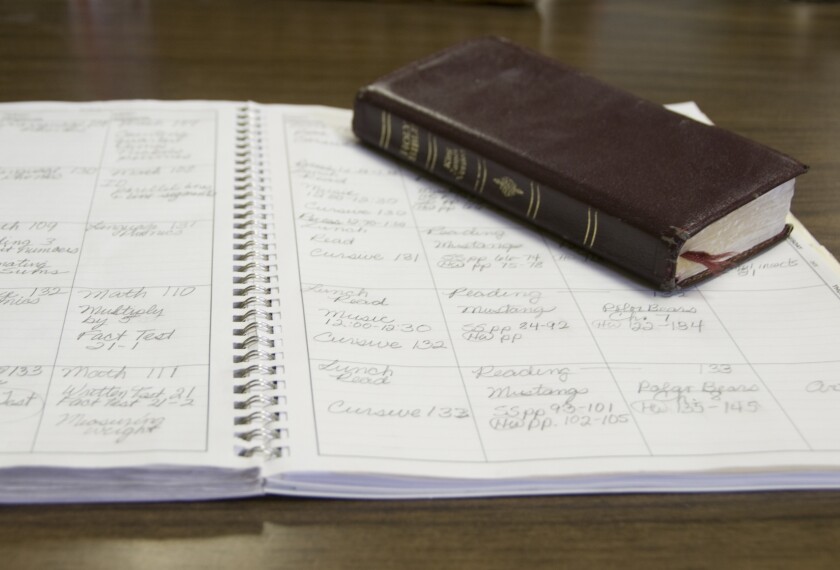For most of my 14 years of teaching, I’ve assigned “bell work” while attending to beginning-of-class duties. For longer than I care to admit, my bell ringers were bad.
These mini-assignments were well-intentioned. My students were writing (writing!) from the moment class began. That was great, right?
My old stand-by was “revise this paragraph in 5-7 minutes.” Then I’d ask for volunteers or call on someone to read aloud a revised sentence and explain how it had been transformed. But I kept noticing simple sentences, uninspired diction, monotone voice. Why weren’t they getting it?
I have since designed three campaigns to overhaul how my class begins. (By the way, I teach English, but these could be used by any teacher who seeks to improve literacy).
The First Push: Improving Vocabulary and Sentence Patterns
We begin with worksheets. A box at the top of each worksheet contains six to eight words from our weekly academic-vocabulary study. Below that, I list the days of the school week, leaving ample space for student writing beside each day. I assign each day a different sentence pattern from by Ann Longknife and K.D. Sullivan. The challenge: Imitate the day’s sentence pattern while correctly using a vocabulary word in context.
Plenty of tools are available: vocabulary books, dictionaries, our class set of sentence-pattern books. After several minutes, volunteers share their sentences under the document camera.
Soon, the more competitive students seek to out-do one another by correctly using as many vocabulary words as possible in a complex sentence pattern. They desperately want to share their writing with the class.
After a few weeks, I drop the worksheets. Instead, I write the vocabulary words on the board, adding the number of the day’s sentence pattern or choice of patterns. (Turns out that limiting the options doesn’t limit my students’ creativity. They need those guide rails to feel comfortable with writing more complex sentences).
Finally, I pull vocabulary words only from our current major unit of study (Fahrenheit 451, The Tragedy of Julius Caesar, etc.). On Fridays, we draft a paragraph by combining the week’s sentences into a coherent unit, adding transitions as necessary. When students share especially impressive paragraphs under the document camera, oooohhhs and aaaahhhs break out across the classroom!
Next Up: Close Reading Done Right
The links between close reading, strong arguments, and skillful writing are undeniable. This campaign is grounded in short articles, blog posts, and editorials I share with students. Students tackle different tasks each day of the week:
Monday—Read the text from end to beginning, noting sentence structure and academic vocabulary (including jargon). Highlight short sentences in one color, longer ones in another. Note anything unusual, such as rhetorical figures.
Tuesday—Identify unfamiliar (or especially sophisticated) words found in yesterday’s reading. Consider synonyms and determine why the author chose that specific diction. (My goal: Help students see how writers find “just the right word” to express their ideas).
Wednesday—Re-read the text and find evidence that helps them determine the author’s purpose, main idea, targeted audience, and tone.
Thursday—Write three to four original sentences in a response to the text. In the response, emulate sentence structures or specific vocabulary found in the text.
Friday—Share yesterday’s response aloud. (This leads to animated discussions as students voice their opinions on current issues!)
The Final Frontier: Tone Chips
Remember the monotone voices I’d noticed in my students’ writing? I realized that the first few minutes of class were a great time to expose students to bits of writing that are anything but neutral: short excerpts, fiction, essays, poems, drama, speeches.
The first time I tried this exercise, I printed the excerpts on large note cards, then laminated and numbered them. Next: a trip to the hardware store to gather paint chips featuring three to four varying shades of a color. I labeled each tone chip with a word, its part of speech, definition, and synonyms.
Students do something different with the excerpts and chips each day of the week:
Monday—I give students an excerpt or a tone chip. Students mingle to find the tone that matches their excerpt. They love arguing over a particular tone chip if there’s competition for one! Once (somewhat) satisfied, each student writes down the tone word and the number of the text excerpt.
Tuesday-Thursday—Students get in the pairs established on Monday and reveal their tone/excerpt matches to the class under the document camera. The fun: Sometimes they discover a more precise tone elsewhere in the classroom. It’s all in the discovery!
Friday—To culminate, students form a “tone continuum” around the room. They categorize tones in general, such as “sad” or “happy” and arrange the excerpts from least intense degree of “sad” to the most intense. (Again, there is occasionally some productive disagreement about the rankings). The purpose: Improve their understanding of tone in their own and others’ writing.
Yes, these opening activities require a little more front-end planning by me—and certainly absorb more class time—than in the past, but it’s worth it. Better sentences, word choices, tone perception, and a different kind of energy among us all, setting the stage for more complex and sustained tasks. No more boring bell ringers!




